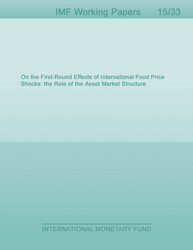
On the First-Round Effects of International Food Price Shocks: the Role of the Asset Market Structure
We develop a tractable small open-economy model to study the first-round effects of international foodprice shocks in developing countries. We define first-round effects as changes in headline inflation that,holding core inflation constant, help implement relative price adjustments. The model features threegoods (food, a generic traded good and a non-traded good), varying degrees of tradability of the foodbasket, and alternative international asset market structures (complete and incomplete markets, andfinancial autarky). First-round effects depend crucially on the asset market structure and the differenttransmission mechanisms they trigger. Under complete markets, inter-temporal substitution prevails,making the inflationary impact of international food prices proportional to the food share in consumption,which in developing economies is typically large. Under financial autarky, the income channel isdominant, and first-round effects are instead proportional to the country's food balance—the differencebetween the country's food endowment and its consumption—which in developing countries is typicallysmall. The latter result holds regardless of the degree of food tradability. Incomplete markets yield acombination of the two extremes. Our results cast some doubt on the view that international food priceshocks are inherently inflationary in developing countries.
Publication date: February 2015
ISBN: 9781498333092
$18.00
Add to Cart by clicking price of the language and format you'd like to purchase
Available Languages and Formats
| English |
Prices in red indicate formats that are not yet available but are forthcoming.
Topics covered in this book
This title contains information about the following subjects.
Click on a subject if you would like to see other titles with the same subjects.
Economics- Macroeconomics , Economics / General , International - Economics , Food Price Shocks , First-Round Effects , Developing Countries , New-Keynesian Models , AssetMarket Structure
Summary
Copyright © 2010 - 2024
Powered by:
AIDC



